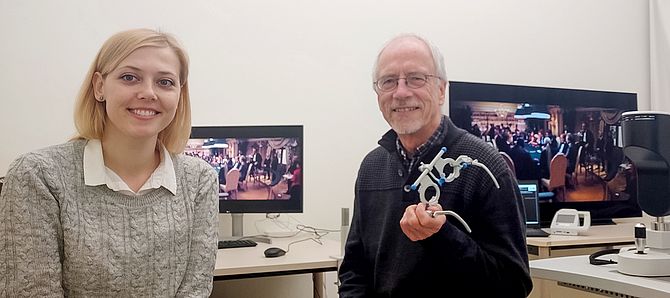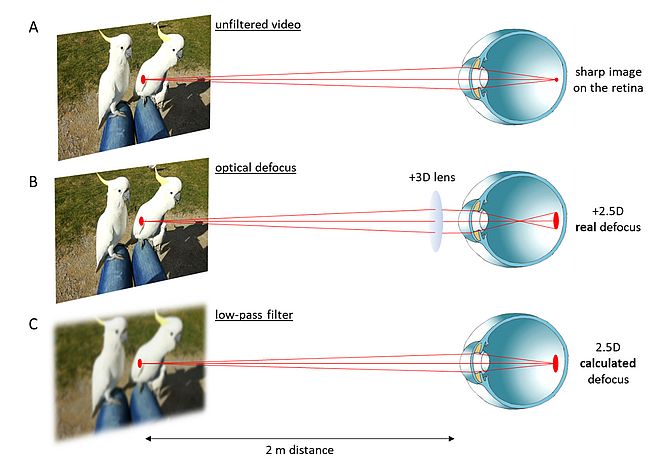You are here: vision-research.eu » Vision Research » Vision in the European Focus » Vision in the European Focus - Details
Why does myopia develop in the first place?
Frank Schaeffel and his colleague Barbara Swiatczak are investigating why short-sightedness develops in the first place. It is known from many studies that the retina, in addition to vision, also controls the longitudinal growth of the eye. If the image on the retina becomes blurred, for example by placing a lens in front of the eye, the growth of the eye changes for some time until the image becomes sharp again despite the lens. The big question is: how do we explain the development of myopia in children? When is the image on the retina in children so blurred that eye growth increases?
A new approach to this question has been developed at the Institute of Molecular and Clinical Ophthalmology Basel (IOB). Frank Schaeffel explains: "Young test subjects watched films on a large screen. On the one hand, software was developed with which the films could be blurred. In the comparison experiment, the subjects were given glasses that made the film just as blurred."
So on the retina were blurred films in both cases, but once calculated, and once caused by glasses. What would one expect? That the retina would react in the same way in both cases? After all, the extent of the blurring was the same. Surprisingly, however, the retina reacted differently.
"With blur through the preset lens, the eye of normally sighted subjects actually became slightly shorter, but with calculated blur it became slightly longer - obviously the retina was able to distinguish between the two cases. Fortunately, these tiny changes in the micrometre range can be measured after only 30 minutes with the optical techniques available today," says Frank Schaeffel.
When short-sighted subjects were examined, it was shown that the retina here had "forgotten" to distinguish between the two conditions. Regardless of whether a converging lens was held in front of the eye or the film was calculated out of focus: short-sighted eyes became longer in both cases. While the retina in normal-sighted eyes had the ability to inhibit the growth of the eye, the retina in the myopic eye had lost this ability.
"Through this experiment, it will be possible to find out what exactly has changed in the retina of the myopic eye," Frank Schaeffel is convinced. "The myopia lab at the IOB is looking for visual stimuli that can "motivate" the retina to inhibit the eye's length growth again, even in the myopic eye."
A key question is how the retina can even tell if the film being viewed is out of focus because of a converging lens in front of the eye, or if it was just calculated out of focus.
"We believe that these are fundamental questions for understanding the causes of myopia. Until now, no one has succeeded in completely stopping the development of myopia - probably because the basic mechanisms in the retina are not understood," says Frank Schaeffel.
This work was performed at the Institute of Molecular and Clinical Ophthalmology (IOB) in Basel, Switzerland.
Original Publication:
Swiatczak B, Schaeffel F.
Emmetropic, but not myopic human eyes distinguish positive defocus from calculated blur. Invest Ophthalmol Vis Sci. 2021;62(3):14.
https://doi.org/10.1167/iovs.62.3.14
Correspondence:
Frank Schaeffel,
Institute of Molecular and Clinical Ophthalmology Basel (IOB)
Mittlere Strasse 91, CH-4031, Basel
Switzerland;
E-mail: frank.schaeffel[at]uni-tuebingen.de.





